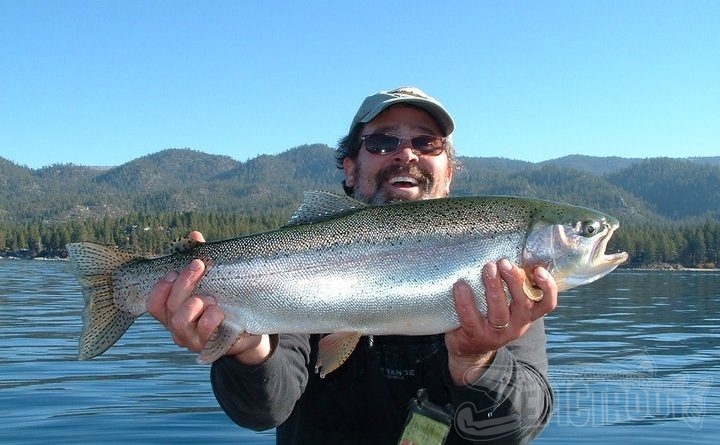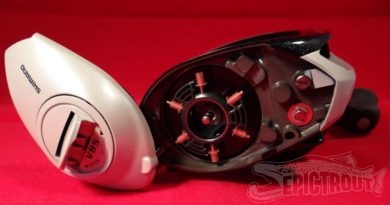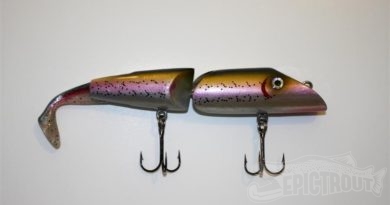The Search for Tahoe Rainbows
The following is a classic article Mark Wiza wrote for a west coast fishing publication over a decade ago. Some things never get old though, and Mark’s tips for catching the big ‘bows of Tahoe are just as useful today. With fall topline trolling time just around the corner, it’s time to bring this great read back for a new generation of anglers here at Epic Trout!
-Brad Stout, September 3 2013
The Search for Tahoe Rainbows
By: Mark Wiza
October 30, 2001
Lake Tahoe is flat calm, a twenty mile sheet of glass. The sun is orange and striped as it rises behind tight bands of high-altitude clouds. I manage to ignore the scenic splendor, though; I’m a man on a mission. My eyes are focused on the screen of my depthfinder, which shows a bottom of jumbled rock, with numerous suspended minnows.
When I hear a single ‘click’, I look up at my Shakespeare Intrepid salmon and steelhead rod sitting in its holder, and see nothing unusual, just the soft yet distinct rhythm of the dodger I’m trolling, telegraphed up my line to the rod-tip. I look away for a moment, and then hear again– ‘click, click’. This time I pretend not to notice, craning around to steal a glimpse over the opposite shoulder, where I catch sight of the rod twitching spastically. Sneaky bastard! I whirl and snatch the rig with one hand, simultaneously twisting the tiller with the other, turning my electric trolling motor to high speed. The rod bends over hard then surges even further as the spinning reel’s drag buzzes out ten yards of line.
I mentally coach myself through the next few critical seconds- motor off, start reeling, fast- the fish is quartering back toward the boat, zig-zagging crazily. Try and keep up; bend the rod to oppose each angle it chooses. Then the line goes slack. What the hell? Reel furiously and suddenly it snaps taut again, slicing through the water, leaving a roostertail of tiny droplets as it shoots toward a spot fifty feet or so from my canoe, a spot where I perceive for a split second a submerged form, a silver and white blur hurtling toward the surface. Uh Oh! Thrust the rod tip forward and down into the lake, but it’s too late. The point where the line meets the water explodes as a three pound Tahoe rainbow trout launches itself into the air, pulling the metal dodger with it. The moment it splashes down, it leaps nearly as high again, then flops back to spring up a third time, all before the spray from the first jump has fallen back into the growing bullseye of ripples. YEEHA! Sierra steelhead!
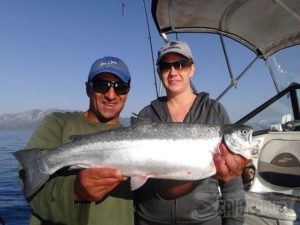
They’re back! Okay, they never really left, but the jet-skis finally have and I’ve recently been able to take the canoe out for one of my favorite adventures- The Search For Tahoe Rainbows. In a lake with kokanee salmon and thirty pound mackinaw, rainbows are at times overlooked. They are caught incidentally by many anglers trying for the other species, but few people target these exciting gamefish, which frequent the shallows near shore, bite on a variety of baits and lures, range in size from ten inches to ten pounds, and are notorious leapers, breaking leaders and throwing hooks with their aerobatic displays.
I can just hear the skeptics out there, asking why I’m making such a big deal about rainbow trout. I mean, come on- rainbows? Aren’t they stocked by the millions throughout California, in practically every lake, stream and reservoir? Aren’t they the trout that eat Velveeta and canned corn? Well, yes, but Lake Tahoe has a way of bringing everything to a higher plane, and when a rainbow trout spends its life in this freshwater sea, it rises to the occasion.
There is a self-sustaining population of wild fish that spawn each year in Tahoe tributaries, and a good percentage of the stocked trout provided by the state of Nevada hold over and grow large as well. Many of the larger fish are silver colored- some local fishing literature refers to an aboriginal strain of rainbow trout known as “royal silvers” that had always lived here alongside the now extinct Tahoe Lahontan cutthroat trout. This seems unlikely, as rainbow trout are not native to any other watersheds on the east slope of the Sierra, and they are known to interbreed freely with cutthroat trout and hybridize whenever the two share habitat. Rainbows have been stocked in Tahoe since the late nineteenth century anyway, and if the lake ever held its own strain of rainbow trout, they are now thoroughly mongrelized through generations of natural crossbreeding with the various strains introduced over the years. The steelhead-like coloration is probably due less to subspecies genetics than the tendency of a rainbow trout in any large stillwater to lose its red stripe and spotting. The metallic, reflective appearance is superior camouflage in the ocean or a deep lake.
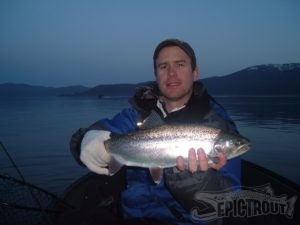
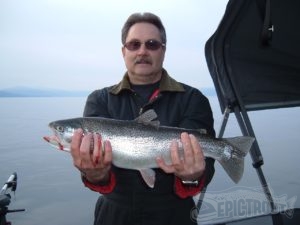
If you’re a dedicated California rainbow trout angler, you may have made the pilgrimage to Eagle Lake, or Almanor, or perhaps Davis, and thought yourself quite a hotshot catching fish on a huge, famous body of water. Those were just training exercises. If you like trolling for big rainbows, try Tahoe this fall. I predict an excellent ‘run’ of two to four pound fish, with a few substantially larger. East shore will be highly productive, with numbers bolstered by this season’s stocked trout as well as fat holdovers that return each year to the Nevada boat ramps, because they were “born” there. The lake’s rocky western shoreline gives up a few less rainbows, but the ones that do show are often large, wild and chrome-plated. What’s more, in all areas where anglers find Tahoe rainbow trout, large mackinaw and browns will move in as winter progresses, hitting the same baits and lures. Check the weather report, check your boat’s safety equipment and get out there!
I’ve been finding excellent action so far this fall, catching a mixture of freshly stocked, holdover, and wild trout averaging 12 to 15 inches. These smaller fish seem to stay in the rocky shallows throughout the lake all year, while the big rainbows form migratory schools, moving to south shore spawning streams in spring, then roaming the lake like salmon, marauding shoals of minnows and snapping crayfish from the rocks. Heavy boat traffic during summer makes trolling the best inshore structure difficult, but with the cold mornings of late, all the drunken summer sailors are gone, and the large rainbows are again returning their shallow water haunts. I last took the canoe out from Cave Rock State Park on October 24 and trolled to Logan’s Shoals, where I found a group of large, aggressive ‘silvers’- trout from 16 to 20 inches that struck trolled Rapala plugs early in the morning. When I switched to a dodger and live minnow I caught even more fish, including one lean, muscular 25 inch rainbow that never leaped, diving out into deep water instead, forcing me dredge it up vertically against powerful dives and head shakes.
Fast troll minnow plugs early and late; slow troll flashers or dodgers with bait all day long. Make either presentation over rocky bottoms and drop-offs from 15 to 50 feet deep. This may sound vague, but in a lake with 72 miles of shoreline, there is only a small, intermittent ring of this shallow structure, and it is easily located with a depthfinder. Still, even expert anglers will need some time to learn the water when they decide to tackle Tahoe. Hiring one of our hard working local guides is a quick way to get up to speed for your own trips- just be sure to specify what type of fishing you’d prefer before booking- you may want to troll for rainbow trout at the surface, but your captain could be planning on jigging for mackinaw 200 feet deep. Anglers are a particularly stubborn and prideful lot, though, and for those determined to learn the hard way, on your own, here are Wiza’s top ten tips for avoiding the big doughnut when toplining for rainbows on Tahoe:
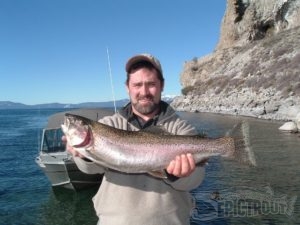
10) Get your ass out of bed. The morning bite rules, and they don’t make boats fast enough to travel backward in time to the sunrise you missed when you slept through your alarm clock because you stayed up too late drinking beer and talking crap about what a great fisherman you are.
9) Don’t hit the snooze button.
8) As soon as you arrive at a shallow rocky area (Zephyr Cove, Cave Rock, Logan’s Shoals, Dead Man’s Point to Sand Harbor, anywhere near Emerald Bay), put out a minnow trap. There is no more consistent bait for Tahoe rainbows than a freshly caught Lahontan redside shiner.
7) Speaking of shallow, hard bottoms I saw my old girlfriend the other day. She reminds me of Tahoe. Damn cold, and so much is flat and featureless; if you spend much time pulling your bait over these areas, your chances of scoring go way down. When you find the rocks and minnows, you have found the trout.
6) Refrain from using cheap, sexual innuendo when talking about fishing.
5) In these uncertain times, it’s important to diversify your portfolio when trolling minnows or nightcrawlers. Dodgers are a valuable asset and have long been used as a hedge against slow fishing. Sep’s Pro Dodger in the silver/prism-tape pattern is currently the most precious metal on the market. Sling Blades from Shasta Tackle Company also enjoyed an initial offering on Tahoe recently, garnering a decent response from the rainbow trout sector.
4) If you are determined to fish with artificial lures, I’ll give you one word of advice– “Balsa!” Specifically the size 9 Rapala Jointed. If you must go with plastics, think big and try the size 14 Rapala Husky Jerk.
3) Whatever you choose to troll, it is critical that you present your offering within a few feet of the rocks. Learn to trust your depthfinder and learn the running depth of your lure. If it doesn’t tap bottom or hang up occasionally, you’re not in the magic zone.
2) Are you STILL in bed? What do I have to do, pour Tahoe water over you?
1) Fish with confidence. Don’t let the big lake intimidate you. Find the structure, put in your time and you will be rewarded. A positive mental attitude is the most powerful fish attractant of all.
Until next time, remember, never stand in a canoe!
Mark Wiza

